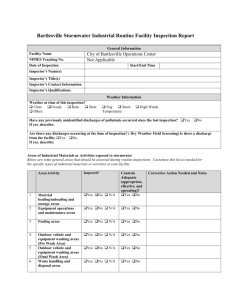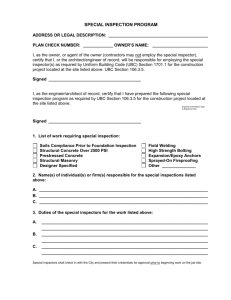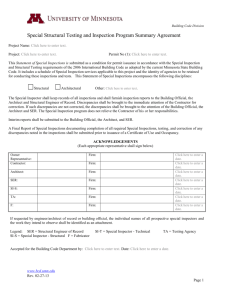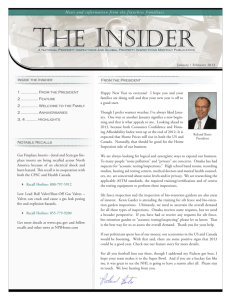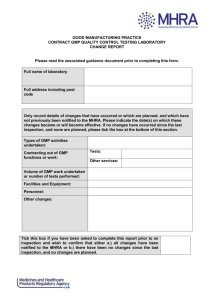Food Safety Regulations And Standards
advertisement
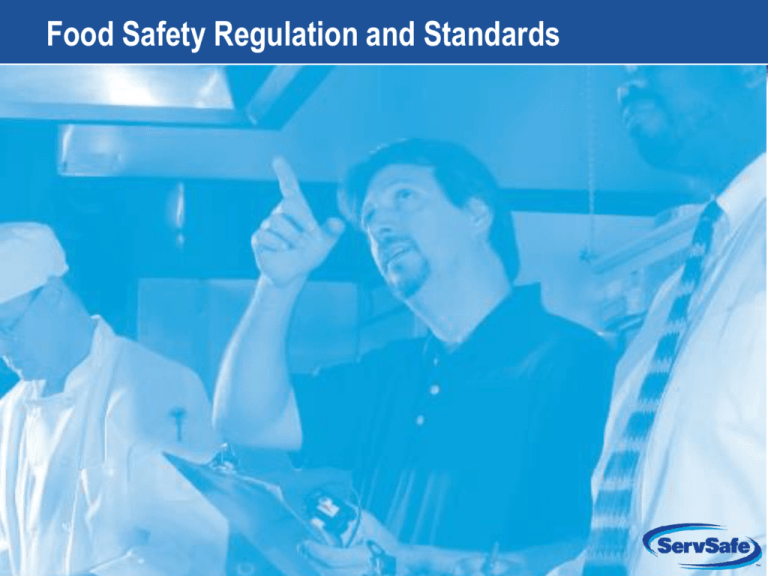
Food Safety Regulation and Standards 14-1 Apply Your Knowledge: Test Your Food Safety Knowledge 1. True or False: The Food and Drug Administration (FDA) issues food regulations that must be followed by each establishment 2. True or False: Health inspectors are employees of the Centers for Disease Control and Prevention (CDC) 3. True or False: You should ask to accompany the health inspector during the inspection of your establishment 4. True or False: Critical violations noted during a health inspection usually must be corrected within one week of the inspection 5. True or False: Establishments can be closed by the health department if they find a significant lack of refrigeration 14-2 U.S. Regulatory System for Food Government control of food is exercised at three levels: Federal U.S. Department of Agriculture (USDA) Food and Drug Administration (FDA) State State health departments Local City or county health departments 14-3 U.S. Regulatory System for Food: The USDA The USDA is responsible for inspection and quality grading of: Meat and meat products Poultry Dairy products Eggs and egg products Fruit and vegetables shipped across state lines 14-4 U.S. Regulatory System for Food: The FDA The FDA Issues the FDA Food Code jointly with the USDA and CDC Inspects Foodservice operations that cross state borders (planes, trains, etc.) Food manufacturers and processors Ensures food processing plants meet standards of purity, wholesomeness, and labeling requirements 14-5 U.S. Regulatory System for Food: State and Local State and Local Control Most food regulations are written at the state level Each state decides whether to adopt the FDA Food Code or some modified form of it State regulations may be enforced by state or local (city or county) health departments Health inspectors from city, county, or state health departments conduct foodservice inspections in most states 14-6 The Inspection Process Foodservice Inspections Are required for all establishments Let the establishment know how well it is following critical food safety practices Types of Inspections Traditional inspections HACCP-based inspections 14-7 The Inspection Process: Steps Steps in the Inspection Process: 1. Ask the inspector for identification 2. Cooperate Accompany the inspector Answer all questions Instruct employees to cooperate Correct deficiencies quickly if possible 3. Take notes Make note of deficiencies pointed out If you question the inspector’s accuracy contact his or her supervisor 14-8 The Inspection Process: Steps Steps in the Inspection Process: continued 4. Keep the relationship professional 5. Be prepared to provide records These will become part of the public record If a request appears inappropriate, contact legal counsel or the inspector’s supervisor 14-9 The Inspection Process: Steps Steps in the Inspection Process: continued 6. Discuss violations and time frames for correction with the inspector Study the inspection report carefully Discuss deficiencies in detail with the inspector. Make sure you understand: The exact nature of the violation How it impacts food safety How to correct it If the inspector will follow up Keep the inspection report on file 14-10 The Inspection Process: Steps Steps in the Inspection Process: continued 7. Follow up Act on all deficiencies noted Correct critical deficiencies within 48 hours or when indicated Correct other deficiencies as soon as possible Determine why deficiencies occurred Evaluate SOPs, the master cleaning schedule, training Establish new procedures, or revise existing ones 14-11 Closure An inspector may close an establishment when there is: A significant lack of refrigeration A backup of sewage into the establishment An emergency, such as a fire or flood A significant pest infestation A long interruption of electrical or water service Clear evidence of a foodborne illness outbreak related to the establishment 14-12 Self-Inspections Well-managed establishments: Perform continuous self-inspections Consider regular inspections only a supplement to self-inspections The benefits of self-inspections: Safer food Improved food quality Higher inspection scores A cleaner environment for customers 14-13 The FDA Food Code The FDA Food Code Outlines federal recommendations for food safety regulations for the foodservice industry Based on input from the Conference for Food Protection (CFP) Although FDA recommends adoption by each state, it cannot require it 14-14 FDA Risk Designations Risk Designations for Evaluating Establishments Priority items Priority foundation items Prevent, eliminate, or reduce hazards (e.g., handwashing) Support priority items (e.g., soap at a handwashing station) Core items Relate to general sanitation and maintenance, (e.g., keeping equipment 14-15
